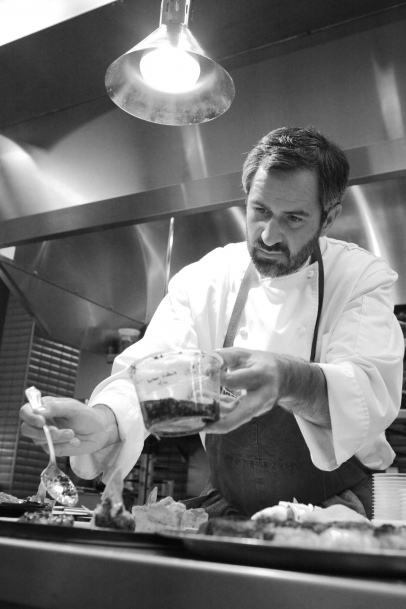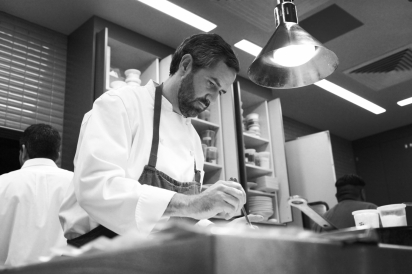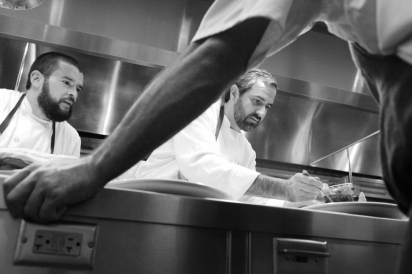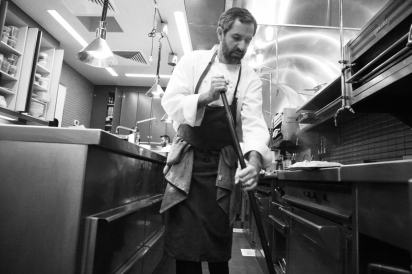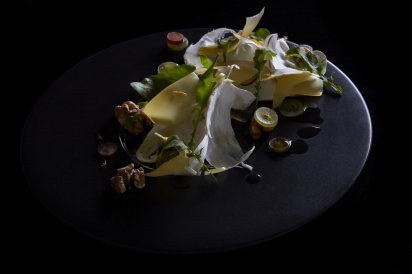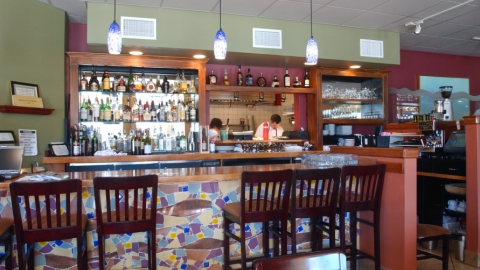The Man Behind Binkley's—A Decade Later
Snap your fingers and, just like that, a decade slips by.
Nine years ago I sat on the edge of a barstool in the most talked-about restaurant in the Valley. I was studying a tall man with a neatly trimmed goatee who, in turn, was intently analyzing an oversized white dinner plate in the window pass between the kitchen and the dining room.
Once the plate passed inspection, a well-trained server whisked it away, ceremoniously delivering it to a diner. This scene repeated itself over and over again during the course of two hours—the time it took me to devour three courses fortified with a lost count of amuse-bouche bites in between.
Edible Phoenix was a brand new magazine at that time and editor/publisher Pamela Hamilton was assembling the inaugural issue. She asked if I’d like to write an article. I told her about my recent dinner at the bar at Binkley’s Restaurant in Cave Creek and about the man behind the window, the one who had captured a James Beard semi-finalist nod earlier in the year. What if I wrote about what Chef Kevin Binkley did all day—from the minute he unlocked the door until he shut off the lights at the end of the night?
My first feature for Edible Phoenix (Spring 2006 - "The Secret Behind the Kitchen Window at Binkleys"), recounted 12 hours I spent shadowing Kevin, a blow-by-blow, hour-by-hour account of his day.
“3:00pm: He tackles the Ono, slicing down one side of the backbone, taking steps as it is too long to cut in one fell swoop, even with his lengthy arm span. He turns the fish and cuts the other side and frowns. The flesh is not smooth. Bad handling, he says, and instead of the 20 portions he was counting on, he only manages 13. The scraps are given to a cook to prepare for the staff meal.”
As Edible Phoenix prepares to celebrate its 10th year, Pamela asked if I’d write another article about Kevin, covering how different his life is a decade later. I asked if he’d be game. “You’re on,” he said, adding with a sly grin, “Things are a little different now.” And so it begins: This marks my 30th feature for Edible Phoenix.
The New Binkley’s
Much has changed since that December day in 2005. The James Beard Foundation has nominated Kevin as Best Chef in the Southwest every year since. He hasn’t won—yet—but he did make it to the final rounds the past three years. That window pass where Kevin inspected plates and peered into his 52-seat dining room is now a wide-open doorway, allowing free flow between the front and back of the house, the result of an extensive kitchen remodel in 2011.
Kevin, now the “elder statesman” at the ripe age of 42, and his wife, Amy Binkley, own four restaurants, with casual siblings Café Bink (2008, Carefree), Bink’s Midtown (March 2013, Phoenix) and Bink’s Scottsdale (December 2013), joining the flagship Binkley’s, which celebrated its 10th anniversary in May 2014. The newest addition is the weeks-old bakery, a 24-seat adjunct to Binkley’s, serving breakfast and lunch. It is also the bread commissary for all four restaurants, and Kevin will use the space for intimate private dinners and cooking classes. Kevin and Amy are in talks for a fifth restaurant in the Southeast Valley.
Noon: Bink’s Midtown
Kevin tells me to meet him at Bink’s Midtown at noon on an unusually warm Tuesday in mid-December. As I pull up to the valet I get a text from Kevin that he’ll be 15 minutes late. Later I learn he’d already clocked several hours at home, poring over bank accounts for the four restaurants. It’s a quiet lunch at Midtown, with just a few tables inside and out, the calm before the holiday storm.
He pulls on a maroon chef’s coat, the official uniform of Bink’s Midtown (and Bink’s Scottsdale) and leads me to the kitchen, a long space divided into three rooms connected by a long hall.
“I love this space,” he says about the cottage house that once housed Sophie’s Bistro. “I’ve had my eye on it for years.”
I’m not surprised at how buttoned up the kitchen is. Some things remain the same; Kevin is still dogmatic about organization and cleanliness. A prep room is on one end and a cooking line on the other. In between is a sliver of a dishwashing station.
I meet Justin Olsen, the chef in charge of both Midtown and Scottsdale, in the prep room labeling a batch of individual bread puddings. After a couple minutes of shop talk, we head to the cooking room and Kevin begins to methodically taste components in deli tubs and small, rectangular metal containers known in the industry as number 9 hotel pans.
“The jalapeños are a little spicy, don’t you think?” he says to the line cook, who replies, “We blanched them, Chef,” but proceeds to work on tamping down the heat. Kevin tries to get to all four restaurants every day but sometimes he only makes it to two. He brags on his team, saying they run the day-to-day operations.
We head to the private dining room, Kevin with two notepads and his computer tucked under his arm, and stop by to check on Amy, who is tucked away in a closet-size office in the back of the restaurant, working on payroll. Between the four restaurants, the Binkleys employ 96 people, 30 at Binkley’s alone. After more than an hour of financial paperwork and phone calls, Kevin rubs his temples.
“This is not the best use of my time, chasing down bookkeeping issues. It’s times like these when I miss cooking.”
Unless you looked closely, you wouldn’t notice his irritation. He operates at a calm, measured pace, often using a soft voice to say, “I’m disappointed,” when others might show more emotion, even shout. He tells me later he isn’t always so collected and one of the byproducts of internalizing his frustrations results in blinding migraines.
Amy pops her head in and says she needs to set up the room for a private party. He seems relieved, ready to put the pencil pushing away.
“Curve balls this morning,” he says, making final notes, crossing off items on his list, before gathering up the notepads and shutting down the computer. “What we’re trying to get away from so I can get back to cooking.”
Kevin checks in with the kitchen and tells them we’re leaving. He’ll spend the next 25 minutes driving from Midtown to Bink’s Scottsdale, listening to new voicemails and returning a call from his credit card processor, clearing up a misunderstanding about a chargeback. In this day of electronic communication, Kevin still prefers an old-fashioned phone call.
2:07pm: Bink’s Scottsdale
Even though it’s well after lunch, a few tables linger on the patio and in the bar at Bink’s Scottsdale. Back in the kitchen, Alex and Marley are in transition from lunch to dinner. “Alex is our sous-chef, or chef de cuisine, or whatever title he wants to call himself over here,” Kevin says. “We’re not too formal with titles.”
“The guy that locks the doors at night,” Alex says. Marley opens up for lunch and Alex comes in later. Marley says she’s been at this restaurant since last May, two months after it opened. “Marley keeps things running smooth until Alex gets here,” Kevin says.
The cooking line is tight, every inch filled with equipment, including four ovens. I spot a huge kettle braiser bubbling with ground meat, tomatoes and spices. It’s Amy’s Bolognese, something that is on the menu in some form or fashion at every restaurant. Instead of each restaurant making its own, Bink’s Scottsdale acts as a commissary, doling out provisions like the Bolognese and handmade pasta to the others.
“That ensures consistency,” Kevin says. “At first, every restaurant was making its own bread and I said, ‘Wait, this is nuts. Who is the best bread baker in the organization? OK, Red at Binkley’s, so from now own, he makes bread for all.’”
He takes me into the matchbox-size office and shows me a row of binders. “We started documenting recipes in a very serious format at Binkley’s three years ago,” he says. Ten years ago, there were no recipes, but then again, there weren’t four restaurants and 20 cooks. More restaurants require more structure.
Kevin tells me he’s working on a cookbook with his friend and professional photographer David Zickl, who pops into the restaurant to see when Kevin might be headed north to Binkley’s. He wants to shoot some dishes later that evening and will set up before we arrive. David attended Arizona Culinary Institute, and did his externship at Binkley’s. He and Kevin formed a lasting friendship and the two spend lots of time together working on the book, which is an equal collaboration between the two. There’s no deadline and they are developing the book in an unusual manner, photographing all the dishes in the Binkley’s Restaurant repertoire over the course of a year to account for the seasons. Once they’ve picked out their favorite dishes, recipe development (for the home kitchen) will begin.
Before we head to Café Bink, Kevin asks Alex if he’s good on prep for the evening. Alex says he could use some help, so Kevin dives in, and recruits me, too, to scrub breakfast radishes and baby turnips, slicing them ultra thin on a mandoline. “You still know how to use a mandoline, don’t you, Gwen?” he asks with a wink. Apparently I don’t, as my slices get a frown for not being transparent enough.
Meanwhile Kevin has dipped a clean spoon into every sauce and relish up and down the line, mostly nodding with approval. A cook is on a stepladder opposite the cooking line, wiping down dozens of glass crocks filled with spices and dried herbs, all lined up in a row and labeled, no doubt alphabetized. Kevin looks at the clock and says we need to roll.
3:52pm: Café Bink
Between Bink’s Scottsdale and Café Bink, Kevin learns he’s booked on TV for a Thursday morning demo, and an old friend who now works at a winery in Napa wants to meet to discuss some wine dinners. He gets a call that an ingredient he had been trying to track down since October is finally coming. Discovering new ingredients is thrilling and he is animated as he tells me about it.
“We’re finally getting some feijoas,” he says. Originally from New Zealand, the walnut-size fruit is sometimes called pineapple guava. He’s only tasted it as a jam, but “I want to see what else I can do with them.”
His iPhone 6 Plus is always buzzing. Ten years ago, his flip phone rarely left his pocket, but then again, he was cooking all day, every day in 2005. I kid him about the phone and he says, “Well, at least I can see it.” He frequently makes notes in the phone and shows me a lengthy stream of documentation, fodder for the meetings he holds with key managers.
“I meet with managers of Binkley’s and Café Bink once a week, and the following week with the other two restaurants,” he says. “I was meeting every week with all four but it was meeting paralysis. This works better.”
I tell him I’ve always loved Café Bink. It feels like a Parisian bistro, a long, narrow space with tight tables and mosaic tile floor. “I designed this space,” he says. “And that was the feel I was going for, with a splash of Southwestern color in the tiles.”
Kevin pokes his head in the walk-in and has a look around. Joe, another long-time employee, is sitting on a stool working on a part with a screwdriver. He tells Kevin a compressor iced over but he fixed it. Kevin says Joe is jack-of-all-trades. He can manage the restaurant, play host, serve and repair anything that’s broken.
“This restaurant practically runs itself,” he says, moving to the line to inspect the hotel pans. He frowns at some, nods at others. Out comes a clean spoon. The aioli is too salty. Instead of issuing commands he offers suggestions.
“How about keeping an apple at the station instead of prepping them in advance?” he asks Tyler, the sous-chef. A few other tweaks are made to the line as well, the result of a joint decision versus a dictated mandate. He acknowledges the adjustments will slow the line down, but only marginally and it will greatly improve the quality. Tyler agrees. Something else hasn’t changed over the years; Kevin’s style of management is still inclusive.
As we prepare to leave to make the four-minute drive from Café Bink to Binkley’s, Kevin seems to catch a second wind.
“Wait until you see the new amuse Brandon [Gauthier] is working on.” Brandon has been with Kevin since the beginning, his right-hand-man, overseeing both Binkley’s and Café Bink. Menu development is still largely coming from Kevin. He writes down compositions that have churned in his head for days and sends them to Brandon, who brings the ideas to life, transporting them from paper to plate.
Kevin is going “home” and he can’t wait to get there.
4:19pm: Binkley’s Restaurant
By the time we arrive, staff meal is well under way. The front and back of house sit down together to eat dinner and discuss the menu. Kevin takes a seat at the bar and I sit at a table. Someone hands me a plate filled with fluffy scrambled eggs, a deli tub holding milk and house-made cinnamon “cereal,” and a couple of salads, no doubt constructed from what was left over from menu items. It’s all delicious, if not exactly perfect pairings.
The only thing different is Kevin no longer runs the meeting. James West, Binkley’s chef de cuisine, is the one grilling the front of the house staff on the menu.
“And how do we make the consommé?” he asks. He gets most of the answer he was looking for, but pitches in with the key to a textbook consommé: the raft, a mixture of raw ground meat and eggs added to the stock to suck up impurities like a sponge, resulting in a crystal clear broth. How something is made isn’t the only thing drilled into servers’ heads. They must know the origin of ingredients: Where do the mussels come from (Prince Edward Island), what is a whelk (a small snail from Cape Cod).
At 4:35pm, staff meal is over, cooks return to the kitchen and servers tidy up the dining room. Kevin leads me to the kitchen and even though I’ve seen the remodel before, the beauty and openness of it strikes me. It’s like no other commercial kitchen I’ve ever seen.
Before, it was a cramped space, with a tight cooking line and a long, narrow workspace behind that, so narrow that two people could barely pass one another.
Now it resembles a home kitchen—if you lived in a mansion and had a staff of nine cooks. Skylights bring in natural light. Shiny, taupe-colored curved tiles adorn backsplashes and walls. Cabinets above workstations have pocket doors, and everything within is organized and labeled. Cabinets below hide refrigerators and freezers.
Trash cans are hidden, just a round hole cut out on each station. “I hate trash cans,” Kevin quips. Every workstation has a sink and power. There are no open-flame stoves anymore, replaced by more utilitarian flattops.
The temperature is also unusually cool for a commercial kitchen. “I’ve got seven tons of air pumping through here,” he brags. “I’ve been a line cook too long under extreme heat. No more.”
And true to Kevin’s nature, it’s sparkling clean. A cook tells me they sweep the floor several times a night during service. I see that, and witness a cook mopping during a lull later in the evening and another wiping the ceiling. You could eat off the floor at any given point during service. I remember Kevin stopping to clean his station the last time I shadowed him:
“4:00pm: The mood in the kitchen switches gears—less talking and a quickened pace. He stops to sweep the floor around his station. No one bats an eye.”
“10:00pm: Kevin plates two last dishes, and then begins to put away his garnishes. He washes the counter and walls with a bucket of hot, soapy water. His stage gleams.”
Reservations for this evening are light, just 21, and I count nine cooks, but learn two are stagiaires, cooks who work for free in return for the experience.
With a fully staffed kitchen and Brandon and James in charge, Kevin turns his attention to the cookbook. David has the space next door, the bakery still under construction, set up as a makeshift studio. There are light boxes, a table, a tripod and a camera tethered to a computer. Over the course of the next several hours, we float back and forth between the noisy kitchen, which is busy but not frantic, and the quiet “studio” where Kevin plates several menu items, including an exquisite matsutake mushroom appetizer.
We slip out the back door of the kitchen on the way to the bakery with photo shoot materials in hand, and I notice the alley in front of the door has been freshly scrubbed. Kevin points to a large vacant lot directly behind the restaurant and says he’s in talks with the owner to farm it. He has always grown things at the restaurant, but on a tiny scale, microgreens for garnish and herbs in a small patch on the east side next to the restaurant. Now he has bigger ideas.
“We want to take it to the next level,” he says. The French Laundry, where Kevin worked after leaving his post as executive sous-chef of Patrick O’Connell’s The Inn at Little Washington, has an enormous garden—a mini-farm, actually—directly across the street, with a full-time gardener on staff.
“Imagine we run out of carrots one evening, and we just walk out the back door and pull some.”
Back in the kitchen, he has a cook retrieve a matsutake that arrived earlier from Oregon. It’s huge, the size of his palm. He brushes it off and, using a peeler, cuts paper-thin slices with feathered edges. “Taste,” he says, handing me a sliver.
Subtle. He tastes pine notes, I taste daikon radish notes. He pairs it with equally thin slices of Asian pear, walnut halves, sliced grapes, a smattering of arugula leaves and slices of rich, butter-colored Gouda. On a black plate it’s striking, and now back in the studio, David shoots 20 or 30 shots, adjusting the angle and checking the result on the computer screen. He is just as meticulous about the shoot as Kevin is about the plating.
A roasted parsnip soup gives them both fits. David works to capture the soup without the wide-rimmed, etched-black bowl dominating the scene. Kevin wants the soup hotter so the horseradish crème fraîche melts just so into the clear broth. They have better luck with a gorgeous, layered crab and Meyer lemon crème fraîche panna cotta.
Back in the kitchen it’s now 7:45pm. All stations are hunkered down, cooking and plating. Kevin slides in to plate a few dishes, his face intense as he swooshes molasses demi-glace on a large, rimmed plate, adding rosy medallions of roasted elk and lining up mini-accoutrements of baby beets, vanilla spaetzle and sugar snap peas, split and splayed open to show pearl-shaped peas the vivid color of fresh cut grass. The final touch is a whisper of beet powder, dropped like grains of sand on the remaining white space of the plate. It’s art, just like all of Binkley’s dishes. They were awe striking in 2005 and they still are today.
Everyone is caught up at 9pm, although several walk-in guests have arrived, so there will be one more rally before it’s over. After Kevin returns from an appearance in the dining room, he asks Brandon to plate up the new amuse-bouche he told me about earlier. It will go through a couple iterations before it’s declared fit for diners.
“Put the lime in the coconut,” Kevin sings, as Brandon constructs the components on a curved, square “spoon.” Macadamia nut butter holds a miniature chunk of barely sweet coconut semifreddo. A drop of intense lime oil is added to the spoon and a garnish of finger lime segments, tiny pink, juicy ovals that burst in the mouth, crown the semifreddo. Chopped macadamia nuts complete the one-bite wonder. It accomplishes everything Kevin looks for in an amuse-bouche: surprise, burst of flavor and delight. Brandon constructs five of them for the photo shoot, and David painstakingly studies each one before selecting one to be photographed.
On the way back to the bakery to shoot the amuse-bouche, Kevin stoops to wipe a spot on the floor. I comment about his obsessive cleanliness. He shoots back “You want to eat at the clean freak’s restaurant or at the place where the guy doesn’t care?” Touché.
At 9:50pm, I catch Kevin in a yawn, although occasionally he pulls 17-hour days, especially during holidays and peak season. “I don’t generally stay until the bitter end anymore,” he says.
He’s making notes again in his oversized phone. He pulls the front of the house manager, Tory, outside for a postmortem, and after her, Brandon is next. It’s 10:20pm now and while Kevin converses with his staff in private, I watch the cooks begin the methodical breakdown. Items are counted, repackaged and labeled, then stored neatly away. Walls are scrubbed, countertops disinfected and notes are taken for the next service.
At 10:34, Kevin says, “We’re out of here.” The staff will be there another hour at least, and they will hold their own postmortem, but unlike nine years ago, Kevin will not be there. He’ll be home. Not sleeping, though; instead he’ll work until 1am, jotting more notes for the next day’s managers’ meeting, reviewing an upcoming holiday menu and churning over yet another new dish dancing in his head.
Some things never change.


